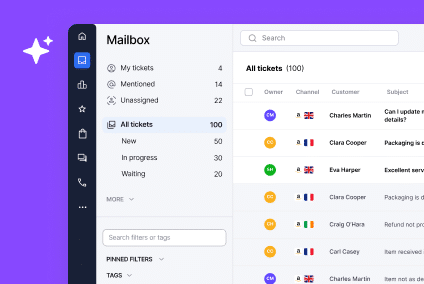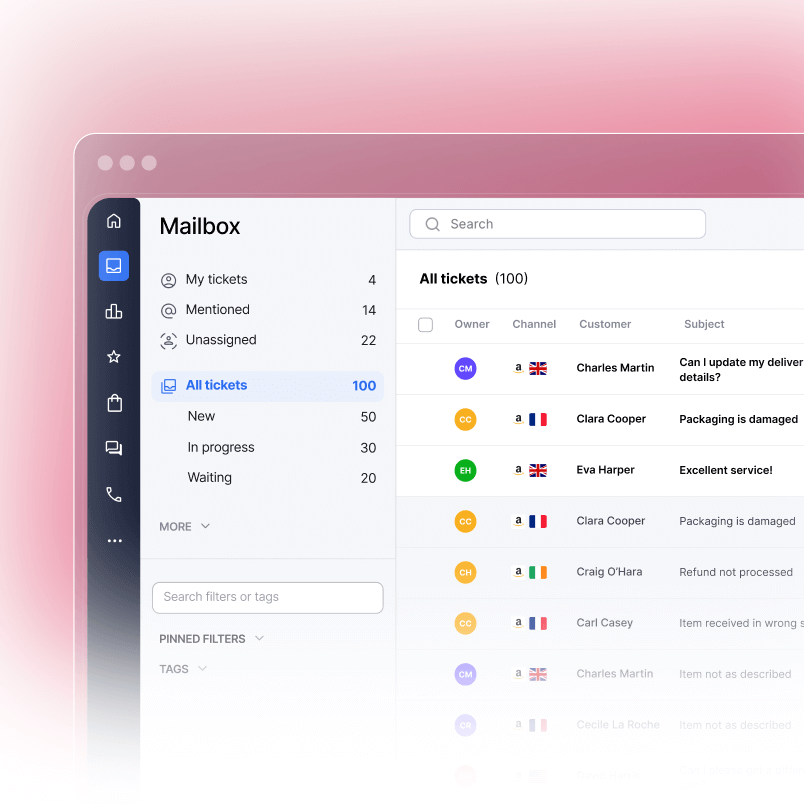If you’ve ever listed a product on Amazon, eBay, or Shopify, you’ve probably come across the term product identifier. In a nutshell they’re those strings of letters and numbers that feel like a secret code for your listings.
But what exactly are product identifiers? Why do they matter so much? And how do you get them right to avoid headaches down the line?
This guide breaks down everything you need to know about product identifiers, from the basics like ASINs and UPCs to the details of when you need them, how to get them, and troubleshooting common issues on your favourite selling platforms.
First up, what exactly is a product identifier?
To put it simply, a product identifier is a unique code that helps marketplaces identify your item from millions of others. It’s like a fingerprint for your product, helping platforms like Amazon or eBay recognize exactly what you’re selling.
Some common product identifiers include:
- ASIN number (Amazon standard identification number)
- UPC (universal product code)
- GTIN (global trade item number)
- MPN number (manufacturer part number)
- EAN (European article number)
- ISBN (international standard book number)
These codes are key to cataloging your items, improving visibility in search, and managing inventory effectively.
Next, let’s take a closer look.
What is an ASIN number, and why does it matter on Amazon?
If you’ve ever listed on Amazon, you’ve definitely encountered the term ASIN number. ASIN stands for Amazon standard identification number. It’s a unique, ten-character code Amazon assigns to every product listed on its platform.
When you’re creating a listing, you might use an ASIN lookup to quickly identify a product that’s already in Amazon’s database. If you’ve ever asked yourself, what is an ASIN, the short answer is that it’s Amazon’s own system for tracking and cataloging products internally.
Keeping your Amazon ASIN accurate is vital, as errors can lead to mismatches, duplicate listings, and visibility problems. Getting it right is also a key part of managing your Amazon Seller Central metrics.
How about the other product identifiers?
Beyond Amazon’s ASIN number, there are a few more key product identifiers that can impact your sales across all platforms:
UPC (universal product code)
UPCs are the familiar barcodes you see scanned at checkout counters in physical stores, from supermarkets to high-end boutiques. If you’re selling new products, marketplaces like Amazon usually require you to provide legitimate UPCs sourced from organizations like GS1.
MPN number (manufacturer part number)
An MPN number is particularly helpful when a UPC isn’t available. Manufacturers assign these unique codes to specific product models or parts, making it easier for customers and marketplaces to accurately identify your item.
EAN (European article number)
The EAN serves a similar purpose to the UPC, but it’s predominantly used in Europe. If you’re selling internationally, especially in European marketplaces, you’ll want to ensure you have an accurate EAN for your products.
ISBN (international standard book number)
An ISBN specifically identifies books and related products. If you sell books on Amazon or other marketplaces, having an ISBN is crucial to ensure accurate listing, visibility, and customer trust.
GTIN (global trade item number)
Think of GTIN as the umbrella term covering several identifiers, including UPCs, EANs, and ISBNs. It’s globally recognized and ensures your products can be accurately identified across marketplaces worldwide.
Item number
If this term sounds vague, it’s because it is vague. It’s sometimes used more generally across marketplaces, especially eBay. It doesn’t always match a standardized code, but it still helps identify your product within individual platforms or inventory management systems.
Each platform has its own rules about when and where to use these identifiers. Amazon, for example, requires accurate UPCs or GTINs especially if you’re part of the Amazon FBA program, while eBay and Shopify offer a bit more flexibility.
Do product identifiers really matter to my business?
At first glance, product identifiers might just look like complicated strings of numbers, but they actually have a huge impact on your eCommerce success:
Improved inventory management
When you use accurate identifiers like ASIN numbers, UPCs, or MPN numbers, it’s easier to manage your inventory precisely. You can track items easily, reorder accurately, and avoid costly stockouts or overstocks. And all of that keeps your business running smoothly.
Better search visibility
You want your products to surface prominently in customer services, right? Accurate product identifiers help you achieve just that. With better visibility, shoppers find your products quicker, increasing your potential sales and conversions significantly.
Fewer returns and mistakes
If your products are clearly identified, you’ll enjoy less customer confusion and errors. Customers receive exactly what they’re expecting, which means you have to handle fewer returns and costly support interactions. This saves you time and improves your reputation as a trustworthy seller.
Easier marketplace integrations
When you properly assign product identifiers, they integrate more smoothly with automation tools, inventory software, and other eCommerce systems. That means less manual work, fewer mistakes, and more streamlined operations across your sales channels.
In short, mastering product identifiers is so important for effectively managing your Amazon Seller Central metrics and making your entire eCommerce business operate more efficiently.
How do you get product identifiers?
Good news! Getting your product identifiers sorted is easier than you might expect.
If you’re after UPC or GTIN numbers, your best bet is to buy them directly from official sources like GS1, Nationwide Barcode, or Buyabarcode.com, or other reputable authorized resellers. It’s tempting to cut corners here, but using cheap or unofficial codes can cause big headaches later, including listing rejections or suspensions.
When it comes to Amazon-specific ASIN numbers, the platform does most of the work for you. Amazon assigns ASINs automatically whenever a new product gets added to its catalog. For products already in the catalog, you can quickly find the ASIN number by searching directly on Amazon or using an ASIN lookup tool.
Manufacturer part numbers, also called MPN numbers, are generally provided by the product manufacturer. They’re especially useful if you don’t have UPCs available. You can usually find them in your product documentation or by contacting the manufacturer directly.
For items that are already listed online or available from your suppliers, you’ll typically find the necessary identifiers printed right on the packaging or provided in your supplier’s documentation. Just be sure to double-check every code carefully. Mistakes, counterfeit codes, or duplicate identifiers can lead to serious issues with your marketplace listings.
When do you need product identifiers for Amazon, eBay, and Shopify?
Amazon
On Amazon, product identifiers are nearly always required, especially if you’re listing brand-new items that aren’t yet in the Amazon catalog. If you’re enrolled in the Amazon FBA program, accurate identifiers like UPCs or GTINs become even more critical because Amazon uses them to track, store, and ship your inventory precisely.
Amazon also heavily relies on identifiers to boost your product visibility, making sure customers can find exactly what they’re looking for.
eBay
eBay doesn’t always strictly require product identifiers for every category, but they’re highly recommended. Including identifiers like UPCs, GTINs, or MPN numbers significantly increases the likelihood of your items appearing prominently in searches, and it builds customer trust by clearly showing exactly what product you’re selling.
For categories like electronics or branded goods, accurate identifiers can even directly affect your item ranking and conversion rates.
Shopify
Shopify doesn’t mandate the use of product identifiers, but they’re strongly advised for managing your product catalog efficiently, especially if your Shopify store is integrated with marketplaces like Amazon or eBay. Proper use of UPCs, MPNs, or GTINs simplifies inventory tracking, streamlines syncing across multiple platforms, and improves the overall accuracy of your store’s search functionality.
Essentially, accurate identifiers make your Shopify store run smoother and help your customers find products faster.
Common identifier issues and how to fix them
ASIN lookup problems
The challenge: Sometimes, when listing on Amazon, you’ll face issues with ASIN lookup, where Amazon struggles to match your product to its existing catalog. This usually happens if your identifiers don’t align perfectly with what Amazon already has listed.
The fix: Double-check your identifiers carefully, confirm your product details match exactly, or reach out directly to Amazon Seller Central support to sort it out quickly.
GTIN exemptions
The challenge: Occasionally, Amazon allows sellers exemptions from providing GTINs or UPCs, especially for handmade or private-label products. But applying for these exemptions can get tricky.
The fix: To avoid listing suspensions, clearly document why your product doesn’t need a GTIN, provide sufficient evidence, and follow Amazon’s exemption guidelines closely. Preparation and transparency are your best friends here.
Duplicate listings
The challenge: Duplicate listings can occur when incorrect identifiers or multiple sets of identifiers are mistakenly used for the same product. This confuses customers, hurts your visibility, and might even trigger account penalties.
The fix: Quickly identifying duplicates and consolidating them under the correct product identifier ensures your listings remain clear and accurate, helping you maintain trust with your buyers and marketplaces.
Rejected identifiers
The challenge: If marketplaces like Amazon or eBay reject your identifiers, it usually means the codes you’re using aren’t valid, authentic, or have already been used elsewhere.
The fix: Always source your identifiers from legitimate channels like GS1, verify their authenticity, and cross-check them before submitting your listings. If you’re stuck, support teams from Amazon or eBay can often quickly clarify what’s causing the rejection.
eCommerce takes more than numbers know-how
So, there you have it. Understanding product identifiers like ASIN numbers, UPCs, and MPN numbers can seem pretty overwhelming on day one. But once you get to grips with what these codes are and how to use them, you’ll find yourself with a serious advantage on Amazon, eBay, Shopify, and beyond.
And getting product identifiers right when you’re exploring the Amazon FBA program, choosing a fulfillment center, or calculating logistics costs makes your eCommerce journey easier. It also makes it far more profitable.
Speaking of making your eCommerce journey easier, don’t overlook the importance of great customer communication. eDesk pulls all your customer interactions from email, social media, live chat, and marketplaces into one simple inbox. Its AI-powered automation sorts and prioritizes messages, so you have more time to focus on growth.
Want to see how eDesk can streamline your workflow? Booking a demo is the best way to find out how it fits with your eCommerce business.




